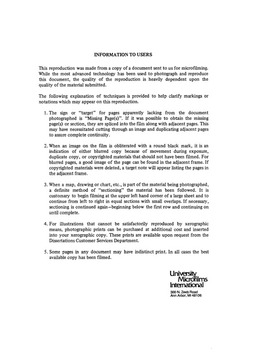| dc.contributor.author | Chebbo, Mohamad Khodr, | en_US |
| dc.date.accessioned | 2013-08-16T12:29:20Z | |
| dc.date.available | 2013-08-16T12:29:20Z | |
| dc.date.issued | 1985 | en_US |
| dc.identifier.uri | https://hdl.handle.net/11244/5331 | |
| dc.description.abstract | Recommendations. Teachers should use textbooks as one of the many resource materials to which they might refer. They should also refer to Curriculum guidelines proposed at State- and Nation-wide levels when developing objectives for their courses. Authors and publishers of textbooks should consider the inclusion of what geographers and educators recommended to provide in a high school geography course or textbook. Authors and publishers should also revise their textbooks, include more concepts and relationships, and use some of the facts provided to support concepts and relationships. Similar studies were recommended to conduct such as content analysis of other geography textbooks, description of changes in their contents over the years, and assessment of the usefulness of the content analysis method for the analysis of textbooks. | en_US |
| dc.description.abstract | Findings and Conclusions. All five textbooks: (1) focused on World geography; (2) approached the study of all regions in the world in a "traditional" and "conventional" way; (3) offered very few of the selected concepts, relationships, and details of selected topics and concepts; (4) relied on the use and provision of factual examples; (5) used summary statements in few instances; (6) relied most on pictures and provided very few tables. | en_US |
| dc.description.abstract | Procedure. The content analysis technique was utilized for analysis and comparison. A list of seven content categories was developed. This list included: Physical, Human, Global, National, and Regional geography, Cartography, and Concepts and Relationships. Each category included several specific points that were analyzed for their inclusion, intensity, and degree of description and examplification. Collected data were re-sorted into nine format categories that analyzed the coverage of: pages devoted to the seven content categories, selected concepts, details of selected topics and concepts, selected relationships, selected facts, some topics for their inclusion or omission, frequency of summary statements, provision of additional points, and frequency of figures and tables. | en_US |
| dc.description.abstract | The major purposes of this study were to do a content analysis of five selected high school geography textbooks and to compare contents provided in each textbook to a list of categories that summarized what geographers and educators would recommend to include in a geography textbook used at the high school level. | en_US |
| dc.format.extent | xv, 219 leaves : | en_US |
| dc.publisher | The University of Oklahoma. | en_US |
| dc.subject | Geography Textbooks 1945- | en_US |
| dc.subject | Education, Secondary. | en_US |
| dc.title | A content analysis study of five selected high school geography textbooks used in Oklahoma / | en_US |
| dc.type | Thesis | en_US |
| dc.thesis.degree | Ph.D. | en_US |
| dc.note | Source: Dissertation Abstracts International, Volume: 46-06, Section: A, page: 1586. | en_US |
| ou.identifier | (UMI)AAI8518304 | en_US |
| ou.group | Jeannine Rainbolt College of Education | |
